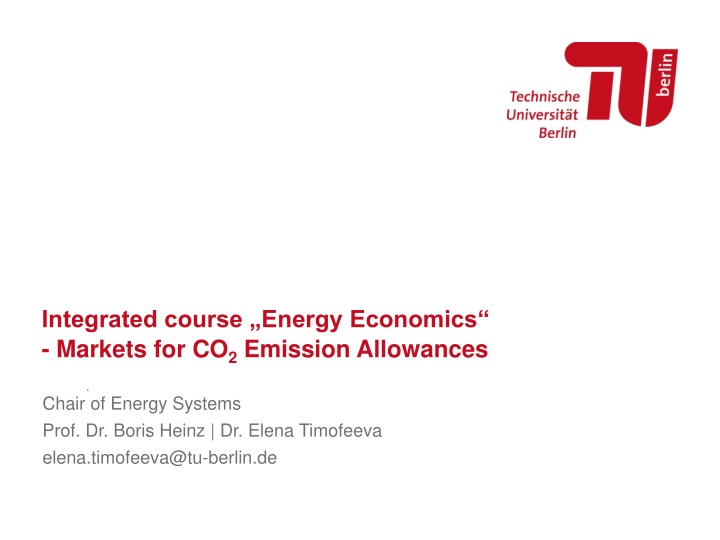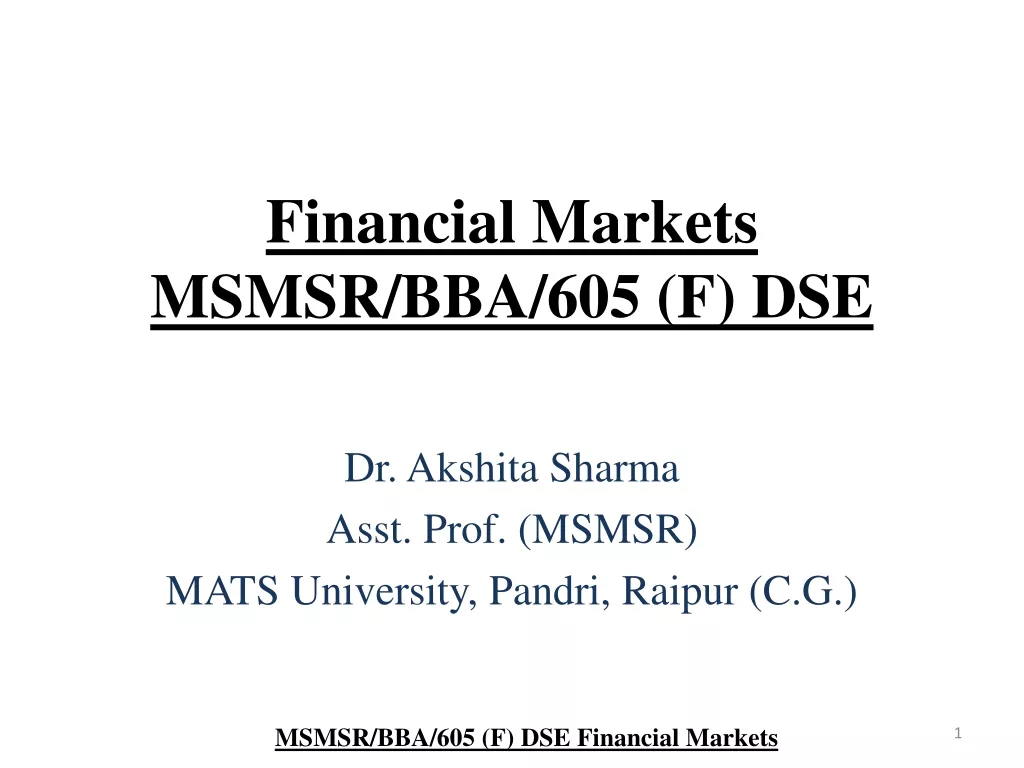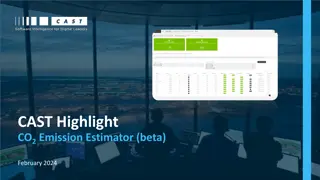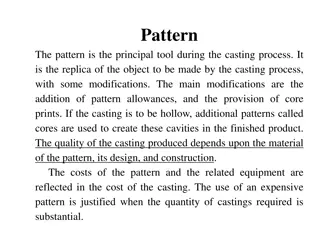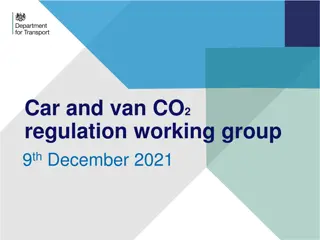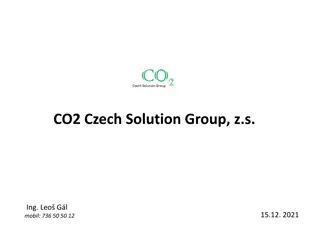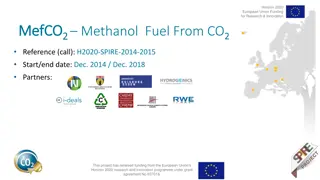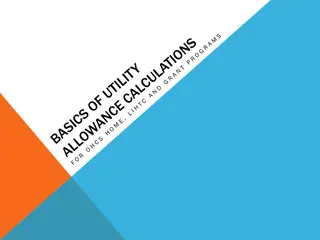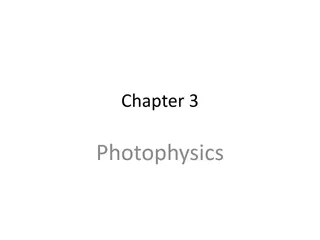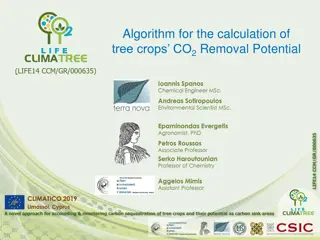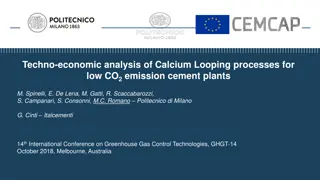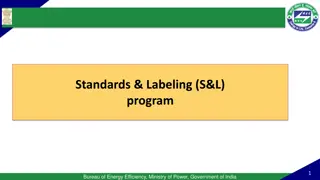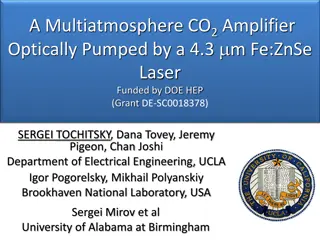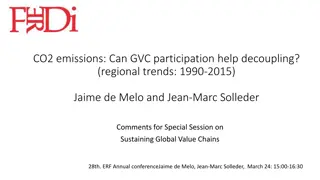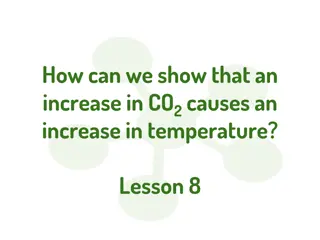Energy Markets and CO2 Emission Allowances
Dive into the intricate world of energy economics with a focus on CO2 emission allowances. Explore external costs, market failures due to GHG emissions, and policy instruments like emissions standards, taxes, and cap-and-trade systems to rectify market inefficiencies. Understand the nuances of quantity and price risks within these policy frameworks.
Download Presentation

Please find below an Image/Link to download the presentation.
The content on the website is provided AS IS for your information and personal use only. It may not be sold, licensed, or shared on other websites without obtaining consent from the author.If you encounter any issues during the download, it is possible that the publisher has removed the file from their server.
You are allowed to download the files provided on this website for personal or commercial use, subject to the condition that they are used lawfully. All files are the property of their respective owners.
The content on the website is provided AS IS for your information and personal use only. It may not be sold, licensed, or shared on other websites without obtaining consent from the author.
E N D
Presentation Transcript
Integrated course Energy Economics - Markets for CO2Emission Allowances Chair of Energy Systems Prof. Dr. Boris Heinz | Dr. Elena Timofeeva elena.timofeeva@tu-berlin.de
Outline External costs Quantification of external costs Greenhouse gas problem European Cap-and-Trade system Seite 2
Task 1) External costs and internalisation a) Explain the term externality in the context of GHG emissions. Externality describes the impact of economic activities on outsiders without compensation. The external effect can be either positive or negative. GHG emissions are associated with a negative externality. b) Why does the externatily of GHG emissions lead to insufficient energy markets? If the external effect of GHG emissions was not included into energy prices, the polluter (e.g. operator of a power plant) would choose a profit optimising production level. By reducing his production he would be less badly off (makes less profit) than the damaged party better off (suffer less from GHG emissions). Therefore, we don t have a Pareto-optimal market outcome (market failure). See next slide. Seite 3
Optimal Emmision Levels Profit External Costs Cext External Costs Cext ( ) E m C E m Maximize ( ) Cext,0 e x t 0 * Profit 0 Em0 Em* Emissions Em
Marginal Damages and Marginal Abatement Costs Marginal Profits, External Marginal Costs d C d d E m d E m dC dEm = e x t ext d dEm 0 Em0 Emissions Em Em*
Task 1) External costs and internalisation c) Which policy instruments can correct this market failure in energy markets? Emissions standard and norms (cap) Emissions tax (Pigou tax) Cap-and-trade system The reason why a cap-and-trade system needs trade (and is not only a cap system) is that the govenment does not know the optimal cap for every installation (lack of information on the abatement costs of every company). Thus, the allocation of certificates is necessarily not optimal. If companies can trade the certificates, the same overall amount of emissions will be abated but at lower costs. d) Explain the quantity risk and price risk in the context of these policy instruments. With a tax system there is price stability. However, as the government lacks information about the shape of the marginal abatement cost function, there is no security of reaching the reduction target (quantity risk). If the tax is too low, emissions will be too high; if the tax will be too high, the emissions will be too low. Resulting costs of the companies are uncertain. With a cap-and-trade system there is security of reaching the emissions target. However, as the government lacks information about the shape of the marginal abatement cost function, there is insecurity about the price of CO2 emission certificates (price risk) and about resulting costs for the companies. See next slides. Seite 6
GHG Abatement Costs and a Pigou Tax Marginal GHG abatement costs [Euro/t CO2] Starting point CO2 emissions
GHG Abatement Costs under Cap and Trade Marginal GHG abatement costs [Euro/t CO2] Starting point CO2 emissions
International Framework on Climate Change 1979 World Climate Conference in Geneva 1988 UN Weltklimarat (Intergovernmental Panel on Climate Change, IPCC) 1992 (1994) UN Klimarahmenkonvention (UNFCCC) Annex I countries: Industrialised countries that have agreed to reduce their greenhouse gas emissions Annex II countries: Developed countries that are responsible for bearing the costs of climate change mitigation in developing countries (subset of Annex I countries) Developing countries: These countries have no immediate responsibilities. 1999 (2005) Kyoto Protocol to UNFCCC Binding CO2 reduction targets: 1st commitment period 2008-2012 2012 Doha Amendment: 2nd commitment period 2013-2020 COP annual Conference of Parties to UNFCCC Seite 9
Kyoto Protocol Greenhouse gases: Sector and source categories: Energy Industrial processes Solvents and other product uses Agriculture Waste + Impact of Land-Use, Land-Use Change and Forestry (LULUCF) Seite 10
The Greenhouse Gas Problem [Data Source IPCC 1990; 2014] Carbon dioxide CO2 280 5 200 1 1 77 60 80 Methane CH4 0.7 0.8 9-15 72 25 14 15 20 Nitrous oxide N2O 0.23 120 289 298 8 70 80 Pre industrial concentration [ppmv] Average atmospheric lifetime [years] Global warming potential in 20 years Global warming potential in 100 years Contribution to the GHG problem [%] Reduction target of the IPCC 1990 [%]
Committed Emission Limits under Kyoto Protocol Source: Burger / Graeber / Schindlmayr (2014) Seite 12
Kyoto Protocol: Flexible Mechanisms Cost-effective options for reducing emissions or removing CO2 in other countries Clean Development Mechanism Project-based reduction of CO2 emissions between non-Annex 1 countries and Annex 1 countries Emission reductions must be additional (compared to baseline). Independent certification Joint Implementation Mechanism Project-based reduction of emissions between two Annex 1 countries International Emissions Trading Emissions trading among Annex B countries Not in use Seite 13
Emission Allowances: Terminology AAU: Assigned Amount Unit or Kyoto unit. An AAU permit to emit 1 t of CO2 or 1 t CO2 equivalent of greenhouse gases. ERU: Emission Reduction Unit. An ERU is a certified emission reduction of 1 t of CO2resulting from a Joint Implementation project. CER: Certified Emission Reduction. A CER is a certified emission reduction of 1 t of CO2resulting from a CDM project. EUA: EU Allowance. An EUA permit operators of an industry installation or electricity generation unit to emit 1 t of CO2under the EU emissions trading system. EUAA: EU Aviation Allowance. An EUAA permit airlines to emit 1 t of CO2under the EU emissions trading system. Seite 14
GHG-Emissions in the EU-27 [Source EEA 2009] Unilateral target: -20% in 2020 compared to 1990 Source: European Environment Agency EEA 2009
EU-27 Composition of GHG Emissions 2007 [Source EEA 2009] (*) 24 % with intl. aviation and intl. maritime navigation
EU Emission Trading System (ETS) For tax issues all EU member states must agree, but majority vote is sufficient for ETS system Mandatory CO2Cap and Trade system for Installations of power, refinery, steel, glass, cement industries (2071 mio t CO2verified emissions in 2005) airline business (after 2011) EU wide annual cap of tradable CO2Allowances (EUA) Almost free allocation of emission rights in the first two trading periods 2005/7 and 2008/12 Windfall profits System is intended to become the prototype for a global cap and trade system
Emission Allowances and Abatement Cost Abatement cost of company 1 (marginal cost) Emission reduction requirements for company 1 Emissions of company 1 Alllocated emissions Em1 CO2emissions
Trade of Emission Allowances Abatement cost of company 2 Abatement cost of company 1 Reductions of company 2 ARBITRAGE Reductions of company 1 Emission right EM1 Emission right EM2 CO2Emissions CO2Emissions
Trade of Emission Allowances Effects of the trade: The given emissions target can be attained at a lower cost. At a given cost, a more ambitious emissions target can be achieved. Seite 20
Designing Emissions Trading System Trading period length: If the trading period is too long, the incentives are weak. If the trading period is too short, there is lack of certainty for investments. Allocation of emissions allowances: Grandfathering free allocation windfall profits CO2 prices are opportunity costs of power plant operators (as certificates could be sold instead of covering emissions from electricity production) and, thus, included into the product price anyway, even if emission allowances are received for free. Auctioning operators buy allowances in auctions. Government collects and redistributes auctioning revenues. In the EU: min 50% for climate and energy related purposes Seite 21
Trade of Emission Allowances Abatement cost of company 1 (marginal cost) Abatement cost of company 2 (marginal cost) ARBITRAGE Allocated rights Emission trade
Task 3) CO2Reduction in Lummerland The island of Lummerland wants to reduce its CO2-emissions by 100 000 tons per year. The industry on the small island consists basically of two main types: castle construction and production of steam engines. Both industries have different CO2-reduction goals with different abatement costs. Castle construction (incl. energy-intensive cement production) Industry A: CO2-reduction goal: 40 000 tons per year CO2-abatement costs per year: ??? = ?.????+ ?.????? ?: ??2 amount per year [1000 t/a] ??? : abatement costs per year [1000 /a] Production of steam engines (incl. energy-intensive steel melting) Industry B: CO2-reduction goal: 60 000 tons per year CO2-abatement costs per year: ??? = ?? + ?.???+ ?.????? ?: ??2 amount per year [1000 t/a] ??? : abatement costs per year [1000 /a] Slide 23
Task 3) CO2Reduction in Lummerland a) What are the abatement costs per ton CO2for Industry A? Slide 24
Task 3) CO2Reduction in Lummerland b) What are the abatement costs per ton CO2for Industry B? Slide 25
Task 3) CO2Reduction in Lummerland c) In order to lower the costs for CO2 abatement, the government of Lummerland introduces a new emissions trading mechanism. What is the theoretical volume traded? Find the volume at which the marginal abatement costs of both industries are equal. Given functions are for annual abatement costs as a function of the annual amount of CO2 reduction. Total required reduction for both industries is 100.000 tons. Slide 26
Second root does not meet the condition (just a matematical solution). Under perfect market conditions 66.123 t CO2 will be abated by industry A. The difference between industry A s abated amount and its reduction target will be traded. Slide 27
Task 3) CO2Reduction in Lummerland d) What is the system price in the emissions trading system? e) What are now the overall abatement costs per ton CO2for Industry B? To be continued Slide 28
